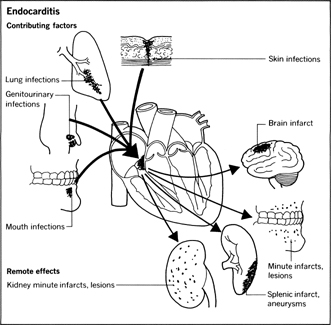Heart Disease - Congenital heart disease
Congenital heart disease includes that collection of heart and major blood vessel deformities that exist at birth in 8 out of every 1,000 live births, or 25,000 cases yearly. Nine thousand deaths annually are attributable to these inborn heart abnormalities.
There are some 35 recognized types of congenital heart malformations. Most—including all of the 15 most common types—can be either corrected or alleviated by surgery. The defects result from a failure of the infant's heart to mature normally during development in the womb.
The term blue baby refers to the infant born with a heart impairment that prevents blood from getting enough oxygen. Because blood low in oxygen is dark bluish red, it imparts a blue tinge to the skin and lips.
The cause of inborn heart abnormalities is not known in most cases. Some defects can be traced to maternal virus infection, such as German measles (rubella), during the first three months of pregnancy when the fetus’ heart is growing rapidly. Certain drugs, vitamin deficiencies or excessive exposure to radiation are among other environmental factors known to be associated with such defects.
Heart abnormalities may come singly or in combination. There may be, for example a hole in the walls separating the right and left heart chambers or a narrowing of a valve or blood vessel which obstructs blood flow, or a mixup in major blood vessel connections—or a combination of all of these.

Diagnosis
A skilled cardiologist often can make a reasonably complete diagnosis on the basis of a conventional physical examination including visual inspection of the infant's general condition, blood pressure reading, X ray, blood tests, and electrocardiogram. For more complex diagnosis, the physician may call for either angiography or cardiac catheterization . The former, a variation of coronary arteriography, allows direct X-ray visualization of the heart chambers and major blood vessels. In cardiac catheterization, a thin plastic tube or catheter is inserted into an arm or leg vein. While the physician watches with special X-ray equipment, the tube is advanced carefully through the vein until it reaches the heart chambers, there to provide information about the nature of the defect.
Advanced techniques known as computed tomography (CT), positron emission tomography (PET), and nuclear magnetic resonance (NMR) may also be used. Both the CT and PET scanners require injection of a contrast fluid so that a “picture” can be taken. The CT scanner takes X-ray images of “slices” of the patient's body with the aid of a computer. The PET scanner works on an electronic principle, with detectors located in a circle around the subject. Also computerized, NMR diagnoses by employing magnetic forces to “see” through bones, revealing such details as the differences between healthy and diseased tissues.
Treatment
From these tests, the cardiologist together with a surgeon can decide for or against surgery. Depending on the severity of the disease, some conditions may require an immediate operation, even on days-old infants. In other conditions, the specialists may instead recommend waiting until the infant is older and stronger before surgery is undertaken. In a number of instances, the defect may not require surgery at all.
Open-heart surgery in infants with inborn heart defects carries a higher risk than does the same surgery in older children. Risks must be taken often, however, because about one-third will die in the first month if untreated, and more than half within the first year.
Refinements in surgical techniques and postoperative care have given surgeons the confidence to operate on infants who are merely hours old with remarkable success. Specially adapted miniature heart-lung machines may also chill the blood to produce hypothermia , or body cooling. This slows metabolism and reduces tissue oxygen needs so that the heart and brain can withstand short periods of interrupted blood flow.
A good deal has been learned, too, about the delicate medical management required by infants during the surgical recovery period. All of this accounts for the admirable record of salvage among infants who would have been given up for lost only a few years ago.

Comment about this article, ask questions, or add new information about this topic: